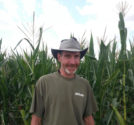Advertise Follow Us
Items Tagged with 'beneficial insect'
ARTICLES
[Podcast] Balancing Insecticide Use and Soil Health Through An IPM Approach
In this episode of the No-Till Farmer podcast, brought to you by Yetter Manufacturing Company, we welcome John Tooker, an entomologist from Penn State University who says, "integrated Pest Management is more than just knowing what to spray and when."
Read More
No-Till Diversity Stretching from Border to Border
Seeding covers to sequester carbon and invite beneficial insects is helping build soil health and reducing input costs for Pierre, S.D., no-tiller Mark Weinheimer.
Read More
What I've Learned from No-Tilling
Efficient Fertility, Cover Crops Set The Table For A Life Of No-Till
Cover crops, specialty products and strategic fertilizer placement provide a yield boost for veteran Pennsylvania no-tiller H. Grant Troop.
Read More







